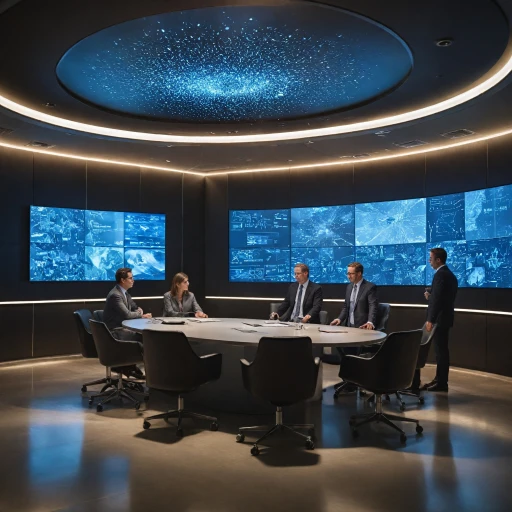Understanding the Strategic Importance of Customer Experience
Why Customer Experience is a Big Deal for Business
Shifting focus to what customers genuinely feel about their interactions with your brand isn't just fussing over niceties. It's about survival in a marketplace where anyone can check reviews at their fingertips. Customers want more than products—they're after experiences that stick.
Recent studies, like the one published by Gartner, show that around 81% of companies expect to compete mostly or completely on the basis of CX (Customer Experience) this year. Customer experience is no longer just about value-added services; it's a fundamental part of the business model that can set you apart.
Personal stories resonate. Think about Starbucks, a company that turned coffee drinking into a personalized experience by knowing your name and order before you even get to the counter. This kind of engagement reflects expertise and builds trust.
What Makes it Tick?
For C-suite leaders, the emotional journey of your consumer base isn't just an afterthought. It's a priority. Facilitating an environment where customer satisfaction is crucial requires top-down commitment—from management all the way to frontline employees.
Customer experience isn't a standalone concept affecting operations — it's connected through every department. Whether through marketing efforts, logistics, or just good old customer service, every link influences that experience.
While looking at how logistics plays into this, consider synchronous logistics technologies, such as the groundbreaking Uber Freight app, which boosts efficiency and ultimately improve the customer's entire journey.
However, it's not just about making singular changes. Introducing a holistic, customer-focused strategy affects not only customer retention but can increase profitability. It's a cycle of understanding, evolution, and improvement that comes from the top.
Aligning Customer Experience with Business Objectives
Connecting Customer Experience to Your Business Goals
As someone at the helm of your business, you've likely faced the balancing act of meeting numbers while striving for long-term triumph. The seamless interaction between customer experience and business objectives is often a make-or-break factor.
Why does this matter? Well, an authentic customer experience strategy aligns with your company’s overall objectives to drive loyalty and profitability. When every touchpoint ties back to your goals, you're not just meeting customer expectations—you’re exceeding them. Look at companies like Amazon who elevate the customer experience, directly correlating it with their mission for efficiency and service excellence.
Walking the Walk: Experience and Values
Alignment needs action. Your promises mean little if they don't reflect customer priorities. Take the case of Zappos, renowned for living their values. Their extraordinary customer service isn't simply a tagline, but an embedded practice ensuring customer satisfaction mirrors their company ethos.
Stories Behind Success: Examples Over Abstracts
Concrete examples ground stories in reality. Consider how General Electric ties customer experience to innovation, allowing the customer to be the north star for their R&D efforts. The evidence lies in improved customer satisfaction scores and increased market adoption.
Drive Through Data
Let’s touch on the analytical side without diving into tech overload. Use data as if it were your trusted ally on this journey. Customer data transformed through actionable insights can steer decisions and foster a client-focused environment seamlessly.
For more on leveraging such data, read about how companies in logistics, like Uber Freight, invested efforts to enrich their customer support operations. Customer insight becomes infinitely more valuable in shaping experiences when paired with a concrete strategy.
Leveraging Data to Enhance Customer Experience
Data: The Goldmine for Customer Insights
In the race to win customer loyalty, data is your best friend. But it's not just about collecting heaps of it; it's about making sense of it. Imagine having a treasure trove of information at your fingertips, waiting to be transformed into actionable insights. That's the power of leveraging data for a better customer experience.
Turning Numbers into Narratives
Data tells a story. It reveals what your customers love, what they dislike, and where they might be heading. By analyzing patterns and trends, businesses can anticipate needs and tailor experiences accordingly. For instance, a retail company might notice a spike in searches for eco-friendly products, prompting them to expand their sustainable offerings. This proactive approach not only satisfies current demands but also builds a loyal customer base.
Personalization: The Secret Sauce
Ever received a recommendation that felt like it was made just for you? That's data at work. Personalization is no longer a luxury; it's an expectation. By using data to understand individual preferences, businesses can create personalized experiences that resonate with customers on a personal level. Whether it's a tailored marketing email or a customized product suggestion, personalization can significantly enhance customer satisfaction.
Real-Time Reactions
In today's fast-paced world, timing is everything. Real-time data allows businesses to react swiftly to customer behaviors and preferences. Imagine a scenario where a customer abandons their shopping cart. With real-time analytics, you can instantly send a reminder or offer a discount, turning a potential lost sale into a conversion.
Data-Driven Decision Making
Data-driven strategies are not just about enhancing customer experience; they also drive business growth. By making informed decisions based on solid data, companies can optimize their operations, reduce costs, and increase profitability. It's about using data to make smarter choices that benefit both the customer and the business.
For more insights on how data is shaping the future of retail, check out our article on retail consulting firms navigating the future.
Building a Customer-Centric Culture
Cultivating a Customer-First Mentality
The secret sauce to elevating customer experience lies in a culture where customers come first. Imagine a workplace where everyone, from the janitor to the CEO, feels empowered to put customers' needs at the forefront of their daily tasks. That’s the essence of a customer-centric mindset.
Fostering this environment requires both passion and persistence. Every team member must recognize their role in shaping customer interactions and experiences. This culture doesn’t happen overnight. It takes consistency, encouragement, and strong roots from the top down, with leadership setting the tone.
One compelling example of this is Zappos, renowned for its customer service. Employees at Zappos are known for going above and beyond, often surprising customers in delightful ways. This mentality isn’t an accident—it's cultivated through hiring practices that emphasize empathy and training programs that empower employees.
Baby Steps Lead the Way
Start small by incorporating customer feedback into decision-making processes. Encourage teams to regularly engage in conversations with your customers. These interactions can illuminate areas where your service can be more effective or where improvements need to be made.
Foster an environment where feedback isn’t just welcomed but rewarded. Link bonuses or recognitions to initiatives that directly enhance customer experiences. This will not only motivate employees but also reinforce the importance of prioritizing customer satisfaction.
When a company wholeheartedly believes that every employee’s input contributes to the customer experience, it aligns all efforts toward creating an exceptional interaction. As a result, customer needs are met with a personalized touch that no amount of AI can provide.
Lead with Empathy
Empathy is the beating heart of a customer-first culture. Leaders should model this quality by truly understanding what customers are feeling and experiencing with the company's products or services.
Try Nokia, for instance—its CEO famously ensured that employees answered customer service calls, including executive team members. This action helped leadership truly understand what customers faced, fostering a deeper connection between the brand and its customers.
This empathy must also extend within the organization, cultivating respect for each team member. When employees feel valued, they naturally pass that sensation onto the customers they serve.
A thriving culture of caring ignites enthusiasm and loyalty both internally and externally, helping businesses not just survive, but flourish in a competitive environment. With keen attention to customer needs and a nurturing environment for team members, you’ve got a winning recipe for unparalleled customer experiences.
Implementing Technology for Seamless Customer Interactions
Technology's Role in Customer Interactions: Making Connections Count
It's all about making life easier for your customers, isn't it? You're not just imagining a seamless interaction—technology is right there, shoulder to shoulder, paving the path. You want customers to feel like they're on the express lane to satisfaction, and rightly so. They've come to expect quick, efficient, and enjoyable experiences.
With your digital tools, think of technology not as a barrier but as an enabler. Automation can handle the routine stuff, leaving your team free to tackle the issues that need a human touch. From accurate real-time updates to predictive analytics, tech gives you the keys to the customer insight vault. Who doesn't love the idea of knowing what your customers want before they do?
Creating a Unified Experience: The Key to Customer Loyalty
Let's put a spotlight on creating a centralized platform that keeps everything singing in harmony. Your CRM systems should speak to your communication channels, online portals, and even your social media pages. This isn't just tech talk—it's about making sure the customer's voice echoes through every corridor of your business.
Customers crave consistency. Disjointed interactions? They're a fast track to frustration. A united front ensures that wherever a customer reaches you, it feels like connecting with an old friend who's on top of their game.
The Balancing Act: Human Touch and Technology
Tech can be your partner in creating those memorable customer moments, but nothing replaces the warmth of human interaction. Striking the right balance is the secret sauce. Think of AI chatbots as your first line of support—they're great for quick fixes, but when the waters get choppy, a human voice can steer the ship.
Your team needs to be as much in sync as your tech. Training that marries customer service excellence with tech prowess creates empowered employees ready to deliver exceptional service with every customer interaction. It's about blending tech support with the empathy and understanding only humans can offer.
Incorporating technology into your customer interactions isn't just a choice—it's a necessity. With these tools, you're not just participating—you're leading the conversation, instilling trust and building loyalty one interaction at a time.
Measuring Success and Continuous Improvement
Quantifying Progress: The Secret Sauce of Success
Once you've made strides with customer experience, it’s time to roll up our sleeves and look at the numbers. Success isn't just a warm fuzzy feeling—it's measurable. You need to know what you're aiming for and track your progress regularly. Are you increasing retention, boosting satisfaction scores, or driving revenue?
Let's talk about setting benchmarks. Identify the Key Performance Indicators (KPIs) that matter for your business. They could be anything from Net Promoter Score (NPS) to customer lifetime value (CLV). Be careful not to drown in data; focus on what moves the needle.
Speed Bumps: Learn & Adjust
Every journey has its detours. When you hit a roadblock, reflect on the experience. Use the feedback loop to find out what's not working and why. Experience tells us that things might not go as planned all the time—and that's okay. Use data insights to tweak processes and redefine objectives.
Always remember, the data should be your guide, not the gospel—listen to your gut too! Sometimes intuition might lead you to uncharted territories, revealing unexpected solutions.
Onward with Continuous Advancement
Customer demands evolve, and so should your strategies. Continuous improvement isn't just a fancy term; it's an ongoing commitment. Encourage teams to innovate and experiment within a framework that allows pivoting without losing sight of the overall goal.
Cultivate an open culture where learning from failures is as valued as celebrating wins. It’s akin to nurturing a garden; every experience adds to your growth. Transform customer feedback into actionable insights, and re-energize efforts by regularly assessing your approach.
Ultimately, the goal is a happy, loyal customer base. When customers trust your business, they bring others along for the ride. This phenomenal success not only reflects in numbers but also in brand reputation and trust.
Engage with your strategies and build on them. After all, the art of fostering lasting customer relationships is rooted in staying responsive, proactive, and visionary.















